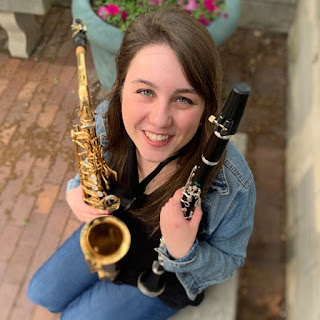Reed span: Ana Nelson builds 'Bridges' in works spotlighting alto sax and clarinet
One of Ana Nelson's pieces on her debut disc, "Bridges," seems to illuminate the path she's followed, from
 |
| Ana Nelson imparts flow and nimbleness to both her instruments. |
a student of classical music into a young professional with a jazz focus.
The disc's third track, "LCB," opens with an etude-like theme, simple but appealing, that flowers against a repeated-note pattern as the music becomes intense.
The prevalence of even notes throughout suggests study and a desire to build upon basics. Her turn from classical music to jazz seems to have been smooth (listen on her website to her pristine account of the second of Stravinsky's Three Pieces for Clarinet Solo). Her legitimate tone on alto saxophone and clarinet alike is thoroughly evident in "Bridges." When she gets a little wild in her solos, the firmly centered tone persists.
In this disc of all originals, Nelson gives notice of her compositional skills as well. The pieces support her academic focus, as she is a doctoral candidate at Indiana University Jacobs School of Music in Bloomington, where she lives.
I was charmed immediately by the first track, "Wanderlust," music supporting the title with its restless rhythmic energy. Her smooth tone packs within it natural ebullience, and her sidemen on this tune and three others are apt for the occasion. They are bassist Brendan Keller, drummer Carter Pearson, and, most crucially, pianist Jamaal Baptiste.
Baptiste is the only one of this group to also have a valuable place in the finale, "Fruit of the Groove." Veterans of the stature of Jeremy Allen, bass, and Steve Houghton, drums, join him there, as the leader brings in a second horn, tenor saxophonist Bill Nelson. Baptiste's best solo of the disc is on this track, I'm guessing because of the inspiring drive of Houghton, who's well-known in Indianapolis as a sideman of Steve Allee.
A shoulder-to-shoulder example of Nelson's musical range is her outing with string quartet only in "Let the Light In." It comes after a visit from her Brazilian muse titled "NelBap Choro," whose title is an abbreviated tribute to her musical partnership with Baptiste.
The most winning exhibition of Nelson's mellifluous tone, a constant on both her instruments, is "Blue Flower," a contemplative piece with the string quartet in the background. The disc's other piece is "Waltz," which goes beyond the blandness of its title with excellent work from Keller and Pearson and some of Nelson's most inventive playing.



Comments
Post a Comment